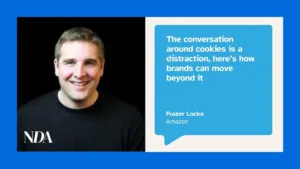Katy Howell, CEO of social media agency Immediate Future, is one of the most innovative and creative leaders in the digital industry and NDA’s monthly columnist.
Human to human; H2H; Human-centric; humaning (rolls eyes); I think I have heard them all over the years. In marketing conferences all over the world, it’s spouted as the latest trend and championed as the ‘new’ company strategy. Like the fact that we market to humans is not stating the bleeding obvious.
In truth they haven’t meant very much other than a strained marketing department trying to sound like the customer is at the centre of everything. When in reality, the company and its growth is.
But there is a change creeping up on us. Maybe it’s the last 12 months being at home, maybe it’s the demise of cookies, it could even be the fact that branding is making a resurgence, but there is a serious air of trying to be more [human] connected to our audiences. I think there are two factors at play, and you can see them clearly on social.
The first is a global behavioural change in the consumer, who just isn’t putting consumption first. Social data has been gradually signalling all this year that family and friends are priority. Brandwatch social intelligence insight at the beginning of the year demonstrated how our New Year’s resolution had shifted. No longer was there a focus on the usual diets and alcohol-free months, instead we all wanted to spend more time with loved ones – friends and family. More recent data looking at the associations with the phrase ‘can’t wait’, in reference to the easing of restrictions, showed we cannot wait to spend time with family and friends – shopping is way down the list. Motivations and desires have changes, possibly for good, but certainly for the immediate future.
Second is the big challenge faced by marketers in a world that doesn’t trust brands. It means performance is being stifled, lead generation stunted and conversion harder work. In a time when growth matters to every brand and agency marketer, this has meant we’ve started to examine the channels that bring us closer to the customer and think more about what the brand means to our audience.
At the recent B2B marketing conference, Digiconf, the sea-change was palpable. Everyone talked about relationships beyond the ‘blah blah blah’ of ‘humanising the brand’. But it was more than talk. There was serious discussion, demonstrable action, and oh, a frisson of excitement that the C-suite were at last getting the importance of customer relationships.
Digiconf, may have been all about B2B, but the way forward for consumer brands was also voiced in a lot of the talks. Hints at what we need to do to step-up on social and beyond.
Back in the day, when I started immediate future, and it was all message boards, myspace and web 2.0, there was much talk and many books about how marketing was a conversation. How customers would want to talk to us companies and we could talk to them. 20 years on and this future, never really came to be. Well, people do talk to brands, when they want to complain. Other than wanting brands to listen when they get it wrong, they have no wish to chit chat with their supermarket, or hang-out with a car marque.
I always liked the idea that people talk through brands. It’s a reference for identity, and chance to share and start conversations with friends. I’m not alone, according to Sprout Social, 78% of consumers want brands to use social to help people connect with each other.
It’s why, whether it’s TikTok or LinkedIn, it’s the entertaining, useful and informative that gets spread through the networks – it’s a chance for our audience to connect with each other. We make our social connections by having a reason to talk to each other. And brands can be the vehicle to do just that.
Interestingly at Digiconf, there were deeper talks on this approach. Businesses are getting to grips with understanding why it’s your whole organisation that is your marketing. It’s brought into sharp focus on social; where the behaviours, attitudes and voices of your employees’ matter and can often be louder or more effective than your own brand.
This then plays it the serious business of community. Nearly all the speakers talked about creating community – whether that was customers, audience prospects or employees. This is not a B2B thing, it is part of the cultural change driven by the pandemic. The need to make deeper connections. Oh I could talk for hours about the branded communities of the early noughties. But it would be mostly about how badly they were set up, how little investment there was and why they quickly lay abandoned after a year or two. Hopefully this time around there is a will to do better. And this could maybe be possible with today’s grasp of customer behaviour and a mindset that being human is a given, and a realisation that it’s customer experience that actually makes the difference.
Across social you can see it. People want to be important to your brand. They want to feel heard. They want you to see that sustainability matters, ethics matter, their everyday matters, to you, the brand. They want more. They want brands to facilitate conversations and help make the world better. Sprout Social uncovered that 62% of people believe social can unify people of different backgrounds and beliefs, and more than half (52%) expressed interest in connecting with individuals different from them.
Putting customer experience at the core of your marketing approach is complex. It certainly goes beyond just social. But social is where the rubber hits the road. It fascinates me and I am talking to a number of brands (please do join me) to understand the reality of delivering joined-up-inside-out thinking. Always easier to talk about than do. Ever really mapped your customer journey? Well, let me tell you, no sooner as it’s done in social, then it changes. Social behaviours, algos and the formats all change. The map is always shifting.
Sure, customer experience is a challenge. Yes, it is the future for brands that want to survive. But I promise you it’s a darn sight easier than the messy, complicated, unpredictable task of being human.









